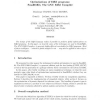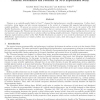1262 search results - page 48 / 253 » Techniques for obtaining high performance in Java programs |
EURODAC
1995
IEEE
14 years 8 days ago
1995
IEEE
As the density and complexity of FPGA-based designs has increased to 10,000 gates and beyond, the use of high-level design languages (HDLs) is rapidly supplanting schematic entry ...
ISSRE
2002
IEEE
14 years 1 months ago
2002
IEEE
Tracing is a dynamic analysis technique to continuously capture events of interest on a running program. The occurrence of a statement, the invocation of a function, and the trigg...
ICSE
2009
IEEE-ACM
14 years 9 months ago
2009
IEEE-ACM
In modern software systems, programs are obtained by dynamically assembling components. This has made it necessary to subject component providers to access-control restrictions. W...
TOOLS
1999
IEEE
14 years 1 months ago
1999
IEEE
The design of the Eiffel language makes it possible to perform global optimizations on Eiffel programs. In this paper, we describe some of the techniques we used in SmallEiffel, T...
LCPC
2005
Springer
14 years 2 months ago
2005
Springer
Titanium is an explicitly parallel dialect of JavaTM designed for high-performance scientific programming. It offers objectorientation, strong typing, and safe memory management...


